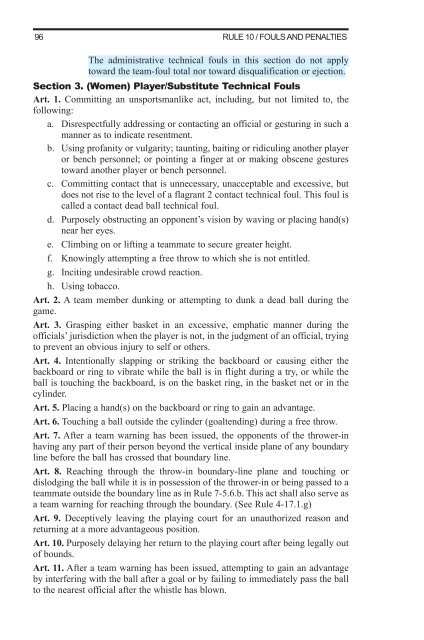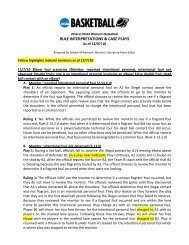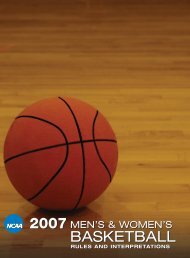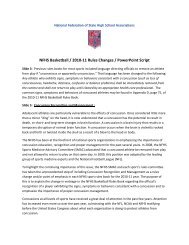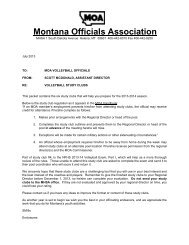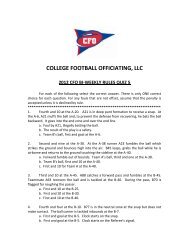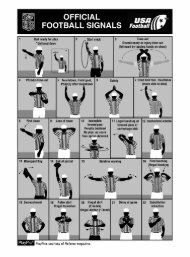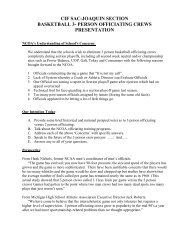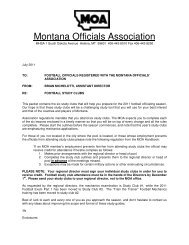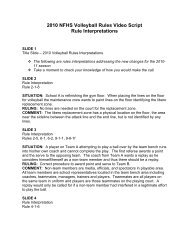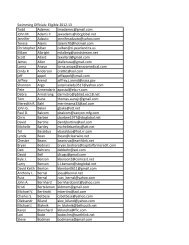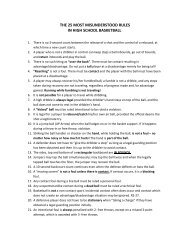2011-12 AND 2012-13 MEN'S AND WOMEN'S RULES - NAIA
2011-12 AND 2012-13 MEN'S AND WOMEN'S RULES - NAIA
2011-12 AND 2012-13 MEN'S AND WOMEN'S RULES - NAIA
Create successful ePaper yourself
Turn your PDF publications into a flip-book with our unique Google optimized e-Paper software.
96<br />
RULE 10 / FOULS <strong>AND</strong> PENALTIES<br />
The administrative technical fouls in this section do not apply<br />
toward the team-foul total nor toward disqualification or ejection.<br />
Section 3. (Women) Player/Substitute Technical Fouls<br />
Art. 1. Committing an unsportsmanlike act, including, but not limited to, the<br />
following:<br />
a. Disrespectfully addressing or contacting an official or gesturing in such a<br />
manner as to indicate resentment.<br />
b. Using profanity or vulgarity; taunting, baiting or ridiculing another player<br />
or bench personnel; or pointing a finger at or making obscene gestures<br />
toward another player or bench personnel.<br />
c. Committing contact that is unnecessary, unacceptable and excessive, but<br />
does not rise to the level of a flagrant 2 contact technical foul. This foul is<br />
called a contact dead ball technical foul.<br />
d. Purposely obstructing an opponent’s vision by waving or placing hand(s)<br />
near her eyes.<br />
e. Climbing on or lifting a teammate to secure greater height.<br />
f. Knowingly attempting a free throw to which she is not entitled.<br />
g. Inciting undesirable crowd reaction.<br />
h. Using tobacco.<br />
Art. 2. A team member dunking or attempting to dunk a dead ball during the<br />
game.<br />
Art. 3. Grasping either basket in an excessive, emphatic manner during the<br />
officials’ jurisdiction when the player is not, in the judgment of an official, trying<br />
to prevent an obvious injury to self or others.<br />
Art. 4. Intentionally slapping or striking the backboard or causing either the<br />
backboard or ring to vibrate while the ball is in flight during a try, or while the<br />
ball is touching the backboard, is on the basket ring, in the basket net or in the<br />
cylinder.<br />
Art. 5. Placing a hand(s) on the backboard or ring to gain an advantage.<br />
Art. 6. Touching a ball outside the cylinder (goaltending) during a free throw.<br />
Art. 7. After a team warning has been issued, the opponents of the thrower-in<br />
having any part of their person beyond the vertical inside plane of any boundary<br />
line before the ball has crossed that boundary line.<br />
Art. 8. Reaching through the throw-in boundary-line plane and touching or<br />
dislodging the ball while it is in possession of the thrower-in or being passed to a<br />
teammate outside the boundary line as in Rule 7-5.6.b. This act shall also serve as<br />
a team warning for reaching through the boundary. (See Rule 4-17.1.g)<br />
Art. 9. Deceptively leaving the playing court for an unauthorized reason and<br />
returning at a more advantageous position.<br />
Art. 10. Purposely delaying her return to the playing court after being legally out<br />
of bounds.<br />
Art. 11. After a team warning has been issued, attempting to gain an advantage<br />
by interfering with the ball after a goal or by failing to immediately pass the ball<br />
to the nearest official after the whistle has blown.


